21 Sep Phool Waalon Ki Sair (procession of flower sellers)
Follow the steps of Delhi’s oldest inter-faith festival
Phool Waalon Ki Sair, or the Festival of Flower Sellers, is Delhi’s very own, unique, inter-faith festival.
Steeped in history and local ethos, the Phool Waalon Ki Sair reflects a remarkable culture that is rooted in Delhi’s distinctive intermingling of religions, built up over the centuries and generations.
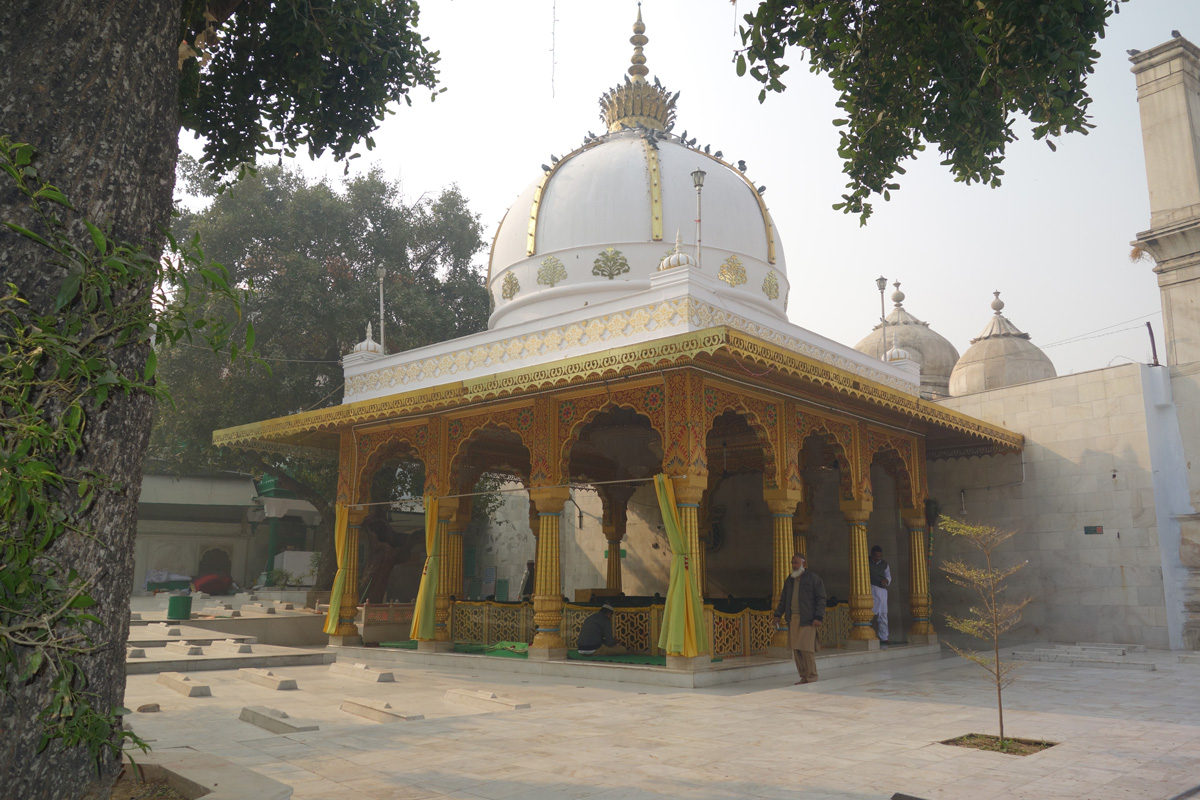 Bakhtiar Kaki’s Dargah in Mehrauli is Magical, Timeless and Full of Charisma.
Bakhtiar Kaki’s Dargah in Mehrauli is Magical, Timeless and Full of Charisma.
Each October, after the rains have blessed the city, a colorful procession of flower pankhas is carried with much fanfare from Mehrauli’s (and Delhi’s) oldest Sufi shrine, the dargah of Khwaja Qutubuddin Bakhtiar Kaki, to the area’s oldest Hindu shrine, Yogmaya Ji’s temple.
One misty December morning, I decided to visit these shrines. I started by ten in the morning, when Mehrauli’s busy lanes are still relatively quiet. My auto driver had heard about a famous dargah in Mehruali, but was clueless as to where it was or how to get there. So, I got off at the Mehrauli bus station and asked for directions. Luckily, the dargah defined this locality, and I was readily pointed in the right direction.
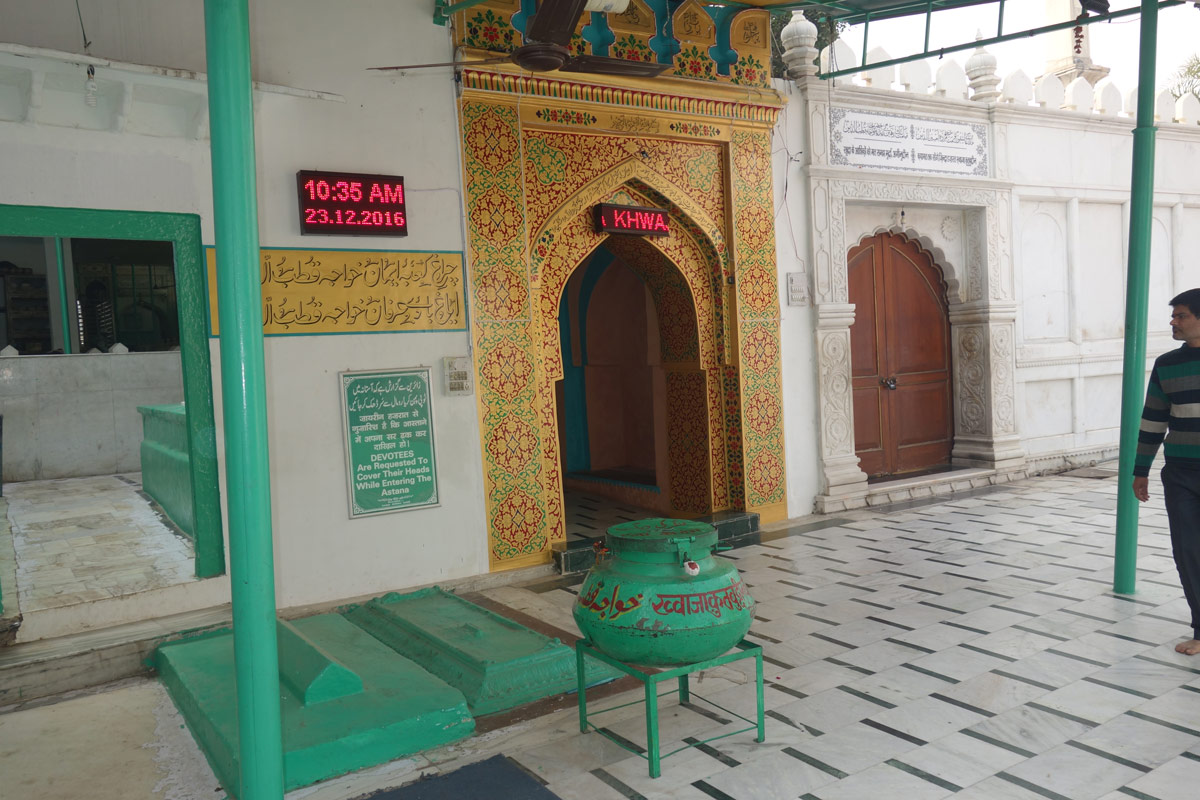 Entry to the Dargah is through a Gold-Colored Doorway; Stepping into a World of Mystical, Medieval charm
Entry to the Dargah is through a Gold-Colored Doorway; Stepping into a World of Mystical, Medieval charm
The entry to Bakhtiar Kaki’s dargah is through an ornate doorway done up in gold. You enter a cool, long corridor with a jali screen separating the corridor from an open courtyard that lies beyond, which houses the saint Bakhtiar Kaki’s grave. Women worshippers, their heads covered, hold on to the jali separation, murmuring silent prayers in the direction of Kaki’s grave.
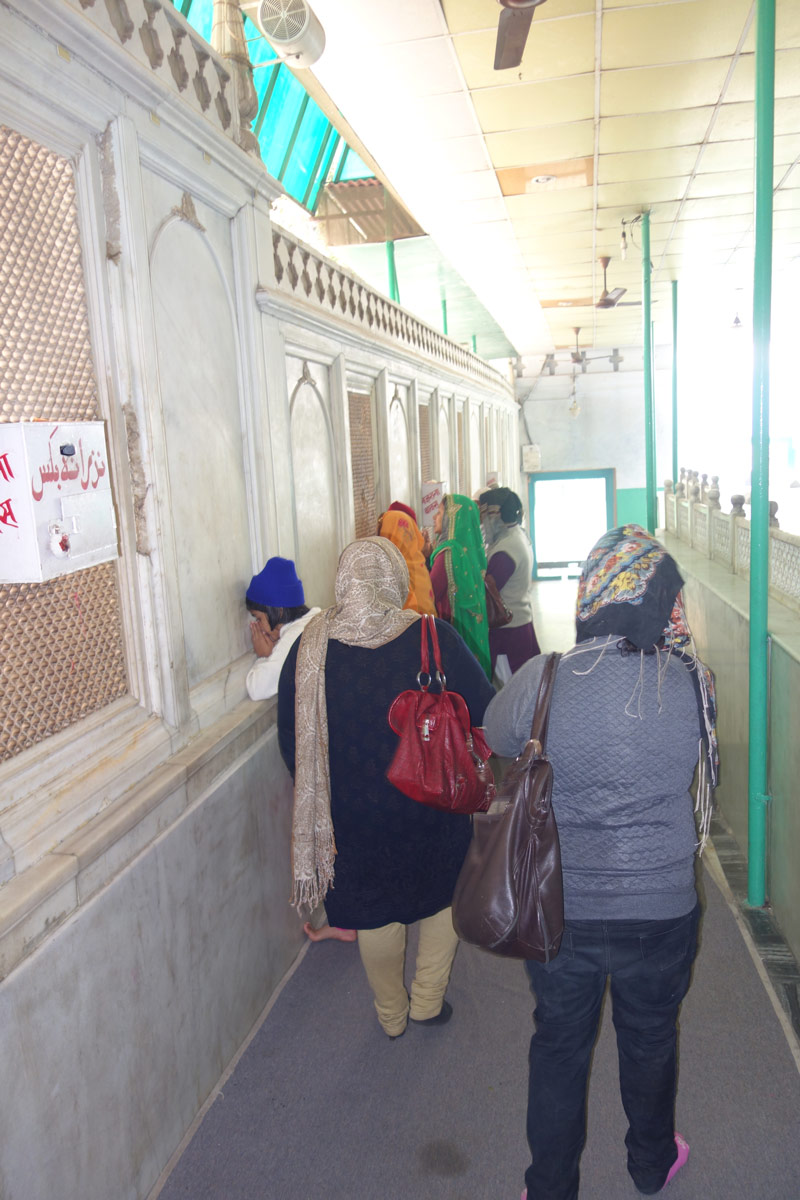 Women Worshippers, Heads Covered, Pray through the Wide Jali Screens
Women Worshippers, Heads Covered, Pray through the Wide Jali Screens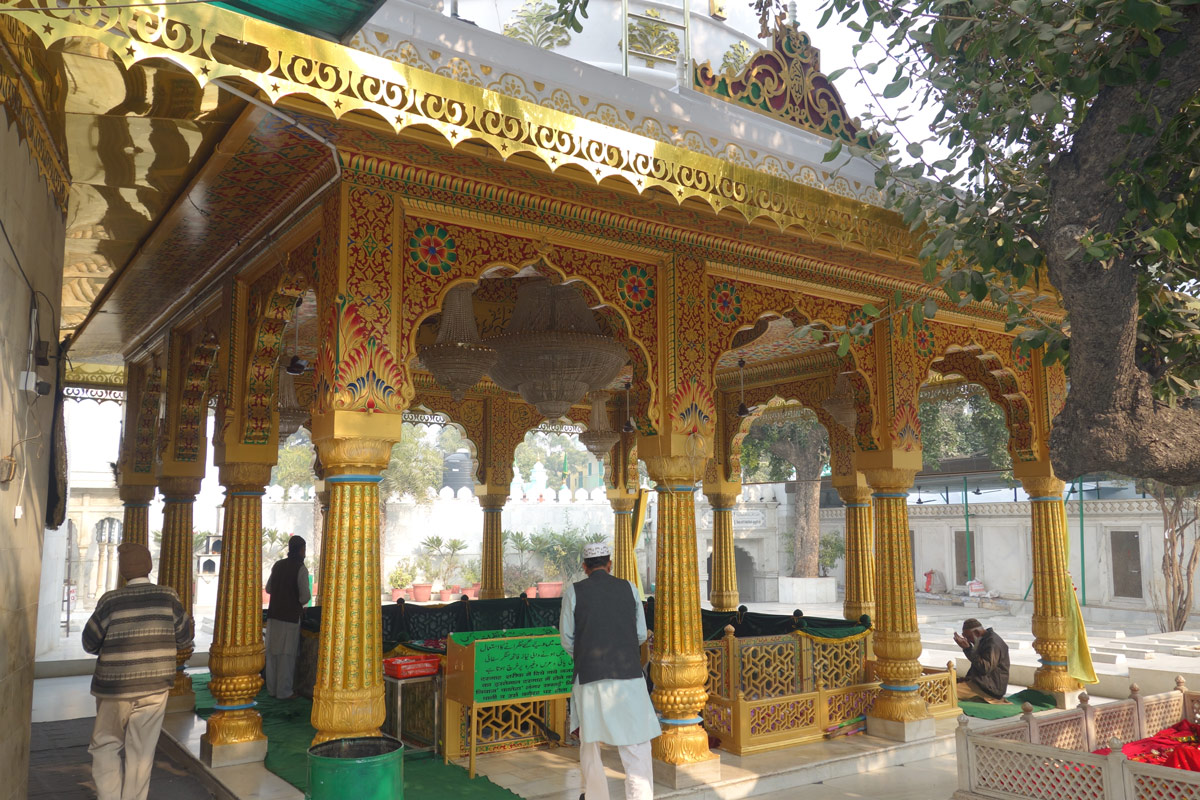 Bakhtiar Kaki’s Grave Lies Quiet and Restful under Its Golden Canopy
Bakhtiar Kaki’s Grave Lies Quiet and Restful under Its Golden Canopy
On one side of the square is the small, white, marbled shrine of Sheikh Abdul Aziz Bistami. It is from Bistami, a great devotee, that Kaki had purchased this land for his kanqah.
Beneath its elegant gold-colored shelter, Kaki’s humble mud grave is covered in a green satin cloth, strewn with red and white flower offerings. A khadim squats on the ground next to the grave. As I approach to offer my nazaara, he lifts the green chaadar for me. I can breathe the sweet smell of incense as I touch my head to the grave.
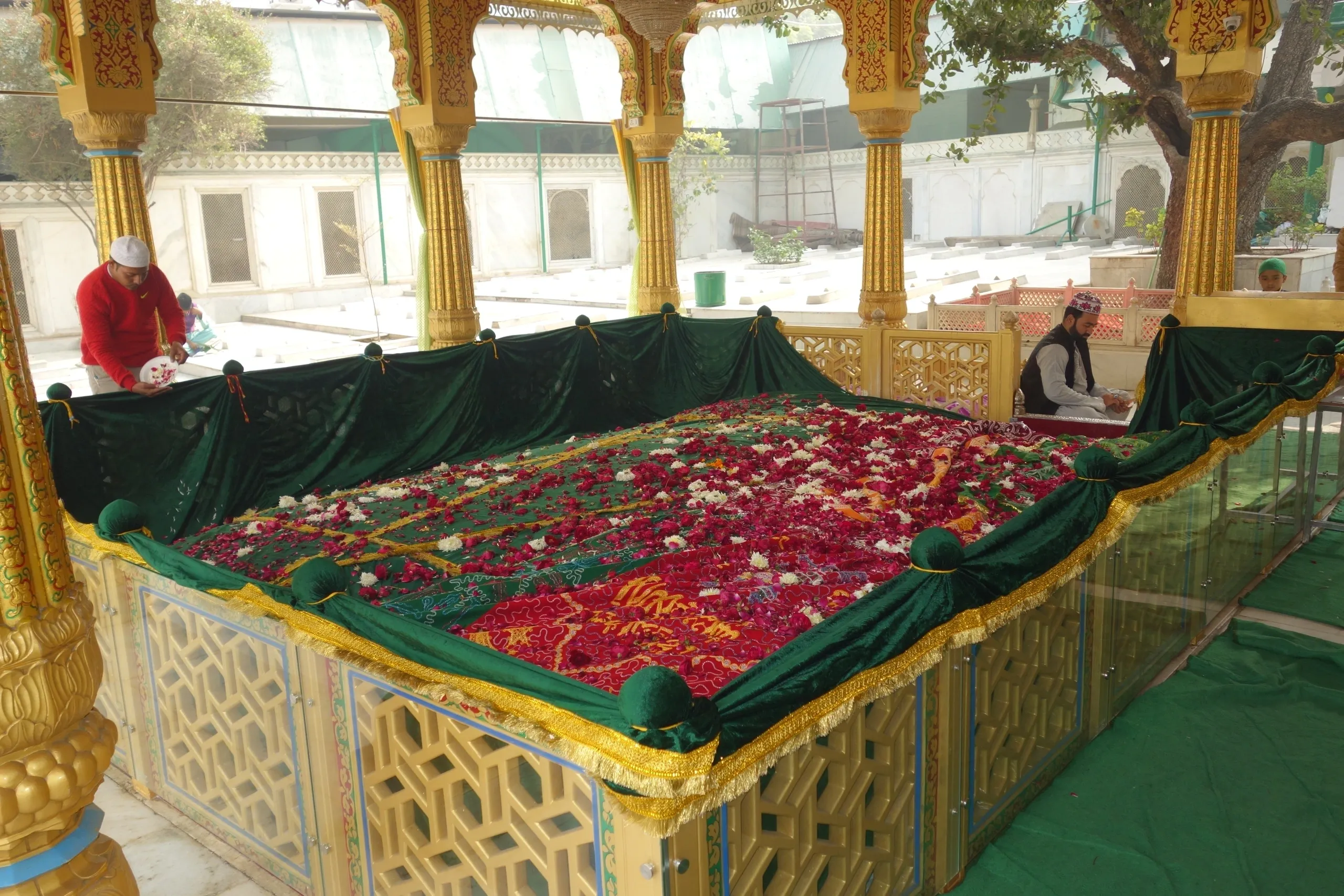 A Green Cloth Covers the Simple Grave, Strewn with Flowers, with the Khadim Sitting by Its Head
A Green Cloth Covers the Simple Grave, Strewn with Flowers, with the Khadim Sitting by Its Head
Making my way to the exit, I meet a member of the dargah committee, sitting cross-legged on the floor behind his small wooden desk. Donations made here, entirely voluntary, are used for the daily langar and for feeding the needy. As the man cuts my receipt, he enquires where I am from. When I mention Bihar, he smilingly replies that he too is from Bhagalpur.
Leaving behind the gentle, contemplative ambience of Kaki’s dargah, I now enter again the bustle of Mehrauli’s ageless lanes.
Yogmaya Ji’s Temple is a twenty-minute walk from the dargah. As I walk back up the slope and towards the temple, I begin to hear the peels of the temple bells. And once again, the final approach to the shrine is lined with neat carts selling flowers and incense sticks.
From the flower sellers at the dargah to their fellow flower sellers at Yogmaya Ji’s temple, the Phool Waalon Ki Sair….a kinship of florists, celebrating their floral offerings over the centuries to different Gods.
I once again take off my shoes and enter the temple through a gate lined with naga heads and adorned with marigold garlands. Inside, a family is having a puja conducted. A priest, clad in a white kurta-pajama, is sitting on the ground in front of a fire, leading the prayers.
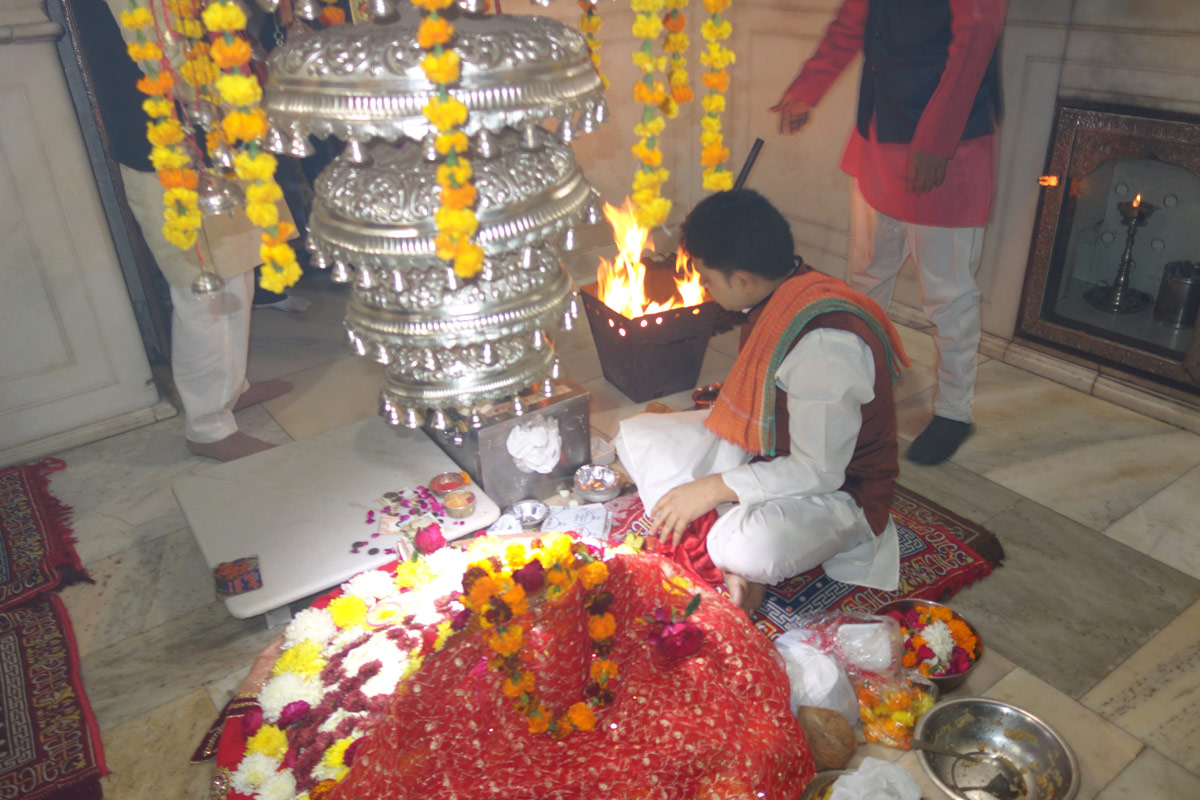 Family Puja at Yogmaya Ji’s Temple
Family Puja at Yogmaya Ji’s Temple Yogmaya Ji’s idol is set back in a small cave-like enclosure, behind a glass panel. A small queue of people are patiently waiting their turn to light diyas in front of the idol. I join the queue to await my turn.
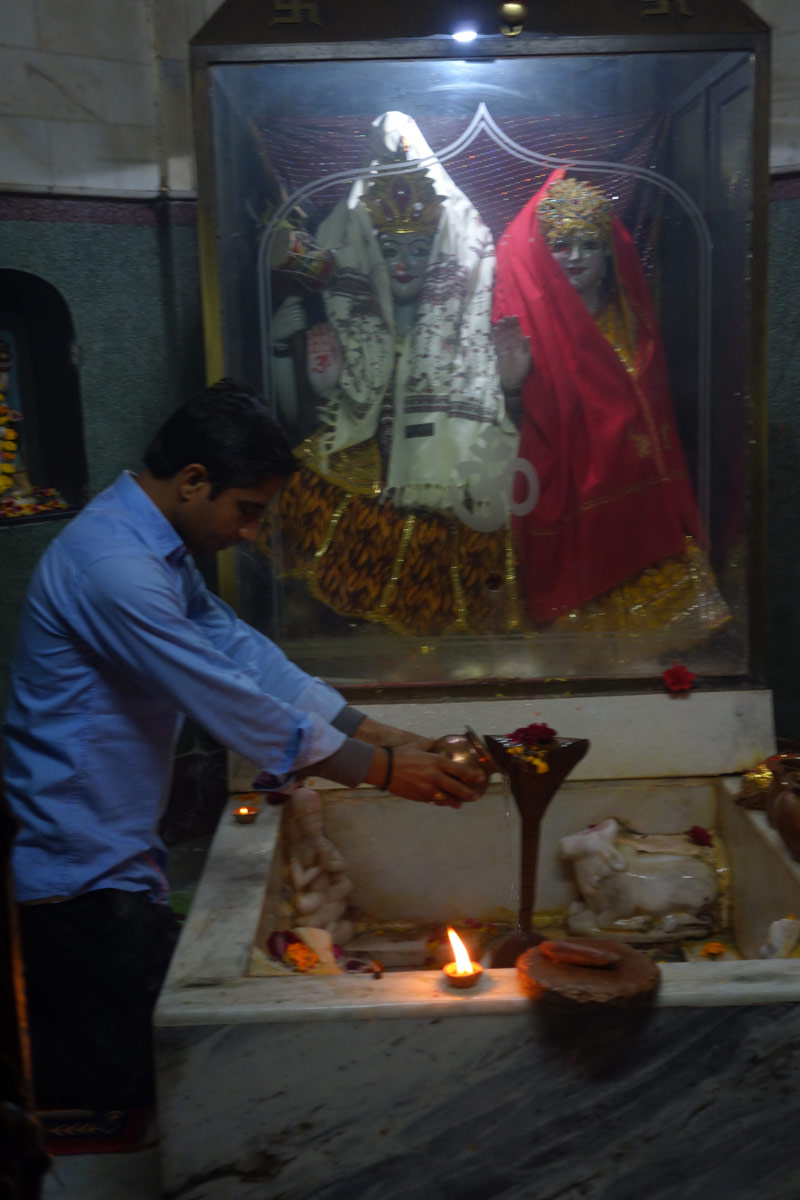 Yogmaya Ji’s Idol, with Diyas Lighting the Front
Yogmaya Ji’s Idol, with Diyas Lighting the Front
Along the perimeter wall of the temple, I find the pankah from the 2016 Phool Waalon Ki Sair placed in a corner.
“Presented by the President of India,” it reads, with the likeness of Yogmaya Ji’s idol and the white dome of the dargah embroidered onto the pankah’s cloth.
As I touch the pankah, I realise I am bonding with the uniqueness that makes Delhi so special. It’s exceptional, syncretic culture. Effortlessly inclusive. Built and layered over the centuries, combining different beliefs.
The Legend of Phool Waalon Ki Sair
Phool Waalon ki Sair is a festival entirely unique to Delhi – its oldest and most colorful inter faith festival and a living example of the intermingling of faiths and culture that Delhi has come to personify.
Phool Waalon ki Sair (literally, the procession of the florists) is held annually in October. A procession of flower-bedecked pankhas (fans), made and carried by the flower vendors, starts from the dargah of the Sufi saint Khwaja Bakhtiar Kaki in Mehrauli, stops at the Yogmaya Temple for offerings and as a mark of reverence and moves on to Jahaz Mahal where it ends with a host of cultural programs.
The history of Phool Waalon ki Sair dates back to 1820, to the reign of Mughal Emperor Akbar Shah II. The emperor’s younger son Mirza Jehangir – brother of the last Mughal Emperor Bahadur Shah Zafar – insulted and shot at the then British Resident in the Red Fort, Archibald Seton.
Seton escaped but was not amused. He had the prince caught and exiled to Allahabad to keep him away from mischief in Delhi. Mirza Jehangir’s mother, Queen Mumtaz Mahal Begum, took a vow that if her son were released from Allahabad and allowed to return to Delhi, she would offer a chaadar of flowers at the dargah of Khwaja Bakhtiar Kaki as well as offerings to Yogmaya ji’s temple.
After a few years, Mirza Jehangir was released, and the Queen redeemed her vow. Large parts of Delhi’s population took part in the merry-making, cutting across communities, and the emperor Akbar Shah, seeing the enthusiasm, decided to make Phool Waalon ki Sair an annual festival.
The last Mughal Emperor, Bahadur Shah Zafar, was a great patron of the annual festival right up to 1857 when he was displaced by the British. The tradition was then continued by Delhi’s prominent citizens and led by the British Deputy Commissioner, the highest government functionary in the city.
When Gandhi launched the Quit India movement in 1942 as part of India’s freedom struggle, the British authorities decided to stop the festival, as they were uncomfortable with the show of communal harmony between Hindus and Muslims.
Phool Waalon ki Sair was re-started in 1962 by the then Prime Minister of India, Jawaharlal Nehru. He saw this as a great symbol of nation-building and personally attended the functions at Mehrauli for as long as he lived. The festival grew in stature under Indira Gandhi, who invited all states to participate, making it a larger national affair. Today, the festival is organized each year in Delhi, after the rains in October, adding to the great tradition of this city’s inclusive society.
More on Qutubuddin Bakhtiar Kaki
Qutubuddin Bakhtiar Kaki was a famous Sufi saint and the spiritual successor of Moinuddin Chisti, the founder of the Sufi Chisti order. While Moinuddin Chisti established his order in Ajmer, it was Bakhtiar Kaki who spread Sufism to Delhi, building his kanqah in Mehrauli in the eleventh century.
Kaki was held in great esteem by the people of Delhi. Iltutmish, who was Delhi’s Sultan at this time, was himself a great devotee. In fact, many of the later Delhi Sultans were devotees, which explains why so many of the Sultanate’s kings are buried in Mehrauli – to be close to Kaki’s grave.
Bakhtiar Kaki was born in Osh, in present day Kyrgyzstan, and joined Moinuddin Chisti when he passed through Osh on his travels, coming with him to India. There are several stories as to how the name Kaki got associated with the saint. Apparently, Kaki’s wife would buy bread on credit from a local baker who taunted her about their poverty. Kaki told his wife not to buy bread on credit anymore and instead take the kak (a type of bread) from a corner of the house whenever she required it. Everyday, the kak would appear in the house as a miracle, and locals starting referring to the saint as Kaki.
Kaki was famous for two of his traits, his frugality and his love for music in prayer. Like all Sufi saints, Kaki lived a life of poverty, despite his intimacy with the Sultan and the high esteem he was held in by royalty. Whatever he received as donations, he handed over to the needy who visited him.
Kaki made great use of music called sama (literally hearing). Sama has been described by Chisti saints as “the hearing of harmonious sounds which move the heart, and kindle the fire of the love of God”.
As Kaki popularized the custom of holding musical festivals in his kanqah, the orthodox ulema of local clerics became increasingly alarmed, as they viewed such musical assemblies un-Islamic. They petitioned Iltutmish to put a stop to this music by using his royal authority. But, Iltutmish, himself a devotee of Bakhtiar Kaki, remained neutral.
While the controversy swirled, Moinuddin Chisti happened to visit Kaki at Delhi. Hearing about these complaints, he feared for the safety of his beloved disciple and asked Kaki to accompany him back to Ajmer. The obedient Kaki bid farewell to his friends and disciples to accompany his master back to Ajmer. It is said that by the time they reached the gate of the city, nearly the entire population along with Iltutmish followed them and urged Kaki to return. Seeing this, an overwhelmed Moinuddin Chisti allowed Kaki to return to Delhi, and Sultan Iltutmish himself escorted Kaki back.
Sufism in India
Sufism has had a huge impact on India and the subcontinent. Though Islam was first introduced to India through the Malabar coast by Arab traders, it is only in the twelfth and thirteenth centuries that larger proportions of the local population converted to Islam, drawn by Sufism and its emphasis on inclusiveness, tolerance and equality. By the thirteenth century, Sufism had become a mass movement, and a number of Sufi orders were established of which the Chisti order was the largest, headquartered in Ajmer.
The Chistis produced a number of great Sufi Masters who were instrumental in cementing its popularity. The first was Moinuddin Chisti in Ajmer, followed by his successor Khwaja Bakhtiar Kaki in Mehrauli and then Fariduddin Ganj Shakar (or Baba Farid), Nizamuddin Auliya and Naseeruddin Chiragh Dilli.
Sufism essentially emphasises freeing oneself from ego. The key elements are renunciation, contemplation, voluntary poverty, abstinence from food and experiencing hunger, all part of the journey towards purifying the nafs, or self, from cravings and towards realizing God.
With the spread of Sufism in India, Muslim and Hindu mysticism influenced each other. Sufis learned breathing techniques and meditation, and there is much in common between the Sufi pir and the Hindu guru, Sufi fana and Buddhist nirvana or Upanishadic moksha.
Sufism’s inclusive pull is best put across by the famous Sufi poet, Jalaluddin Rumi
Come, come whoever you are
Wanderer, worshipper, lover of leaving
It doesn’t matter
Ours is not a caravan of despair
Come, even if you have broken your vow a thousand times
Come, Come yet again. Come.
Mevlana Jalaluddin Rumi
How to get here:
Bakhthiar Kaki’s dargah : From the Mehrauli metro station, take an auto to the Mehrauli Bus adda (depot). Adjacent to the bus depot is a narrow lane that leads downhill to the dargah.
Yogmaya Ji’s temple : Walk back from the bus station in the direction of the Qutub Minar. Within 100 meters, take a lane on the left that leads directly to the temple.
Information:
- Closest Metro : Mehrauli
- Open all days of the week.
- Parking is available near the bus station, but it is best to walk from there.
- No wheelchair access.
Sources:
- Spear, Percival. Delhi Its Monuments and History, Third Edition. Updated and annotated by Narayani Gupta and Laura Sykes. (Delhi; Oxford India Paperbacks 1994)
- Dehlvi, Sadia. Sufism. The Heart of Islam (Published by Harper Collins India, Delhi, 2009)
- Subhan, John A. Sufism Its Saints and Shrines (Published by Indigo Books, Delhi, 2002)
- Eraly, Abraham. The Age of Wrath. A History of the Delhi Sultanate (Published by the Penguin Group, India 2014)

